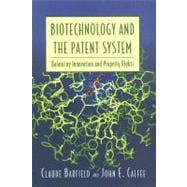Barfield and Calfee clearly explain arcane issues of patent law and the tremendous effect that they can have on our economy, our technological progress, and our health. As Congress considers sweeping changes to the patent law, this book is a timely evaluation of the strengths and weaknesses of the current system and the risk of overly aggressive reform.
Biotechnology and the Patent System analyzes the role of intellectual property protection in biomedical research, one of America's leading growth industries. Barfield and Calfee explore ways in which patent law fosters future research and venture capital investment; they also evaluate whether the current system could potentially impede genomic research and the development of new treatment and diagnostic tools. With these competing concerns in mind, the authors evaluate proposals currently under discussion in Congress (S 1145 and HR 1908) and how they would affect biotechnological innovation and, in turn, the quality of our health care.
These proposals have created passionate disagreements among affected industries, with technology and software companies pressing for fundamental reforms that would shift the balance of power from patent holders to patent challengers. Biotechnology, pharmaceutical, and manufacturing firms, as well as large research universities and venture capital associations, contend that the reform proposals are too radical and would undercut U.S. international competitiveness and retard innovation.
In just a few decades, the U.S. biotechnology industry has gone from a handful of startups to a major industry with a market capitalization of $400 billion and payroll of over 130,000 people. Yet the industry's growth can't mask a simple fact of life for most biotech companies: it is difficult to make a profit because of the high costs, high risks, and extremely long development times in developing biotechnological therapies and devices. In 2006, the industry as a whole lost $5 billion.
Potential changes to existing patent law would f








